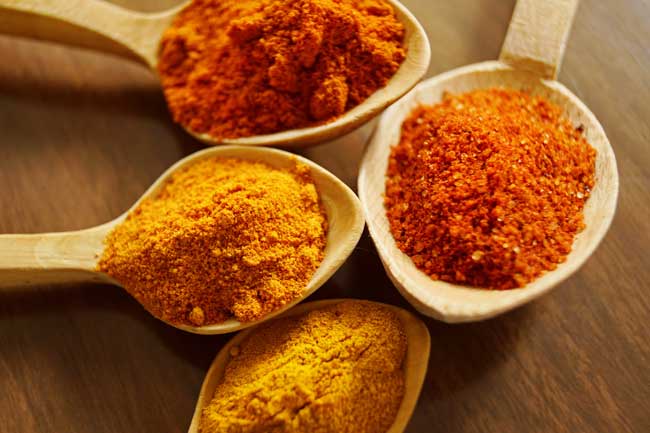
We are reader-supported and may earn a commission on purchases made through links in this article.
Woks smoke and sizzle. Cooks shout. People weave between tables with bowls, plates and cups. It’s dinnertime at the Tekka Centre in Little India, Singapore, and I’m caught in a chaotic swirl of hungry Singaporeans. An old man comes out from his stall, grabs my arm, and says, “Briyani?” Evidently, he’s a mind-reader.

Tekka Centre in Little India
Briyani is a mixed rice dish with origins in Mughal India. You’ll find it in seemingly infinite variations wherever there are Indians. At the Tekka Centre here in Singapore, the blend of basmati rice, onions, herbs and spices is prepared in huge pots with meat, fish or vegetables. Gravy comes on the side but be sure to try it before dumping it over your rice—the heat factor can be considerable.
I ask the old man if he has fish. He does. When the briyani’s ready, he brings it to my table and collects his five bucks. Yes, at the Tekka, you can have a meal served on a traditional banana leaf for only five Singapore dollars. Of course, you’ll have to eat it with plastic utensils—or none at all, if you really want to go Indian—but that’s part of the fun.
I usually opt for a tiger beer to tame the spicy briyani, but today I’m in the mood for Teh Tarik. I love to watch the tea makers pulling this creamy milk tea back and forth from pitcher to glass, creating a delightful froth.
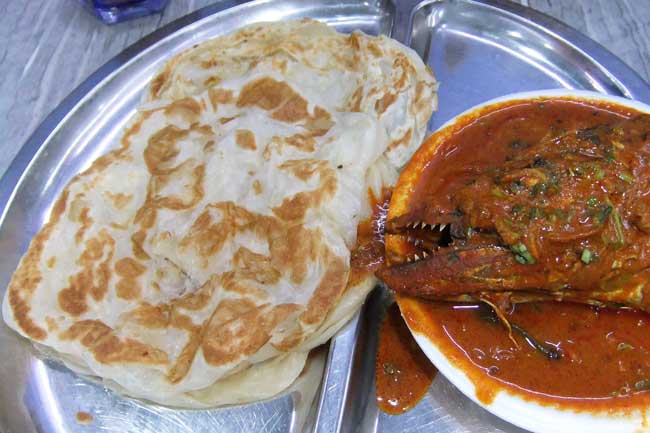
Prata at the Tekka Centre
In the morning, I’m back at the Tekka with Bernard Koh, a popular Singapore guide. He learned about food from his father, who used to cook on the street in the old days, before vendors were required to move to indoor hawker centres.
“Singaporeans love to eat,” says Bernard. “But I never cook. Why would I when I can go to a cheap hawker centre and get the best food? Have you tried prata bread? Incredible.”
He’s right about the bread. Prata, which comes from Chennai in southern India, is stretched, flipped, smeared with butter and fried. Watch the prata men in the Tekka Centre perform their elaborate pulls and flips, and you’ll know why so few people attempt to make it at home.
Prata is a favorite breakfast food in Singapore, and you can get it topped with eggs or cheese or onions. For lunch, I like it with curry. It’s great as a dessert too, slathered with chocolate syrup or ice cream. Look for the cone-shaped confection known as “tissue prata.” This is the thinnest of all prata breads, and the most difficult to make. Try it coated with sugar, jam or honey.
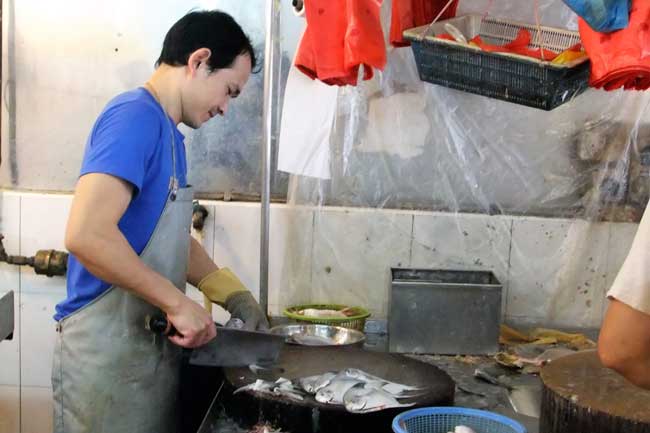
Fishy Business
The Tekka has plenty to offer people who do cook, as well. It’s home to a wet market that’s been in business since 1915.
Bernard takes me through the fish stalls. All manner of fresh seafood is on display, from inky cuttlefish to miniature sharks. Though Singapore is an island nation, some 75 percent of its seafood is imported. There’s very little commercial fishing in Singapore, and coastal and inshore fish farms are only able to produce a quarter of the estimated 65,000 tons of seafood that Singaporeans consume annually.
Baskets and bins of live crabs are everywhere in the market, their claws bound up with ribbons. Many of them will become Singapore’s most famous dish: chili crab.
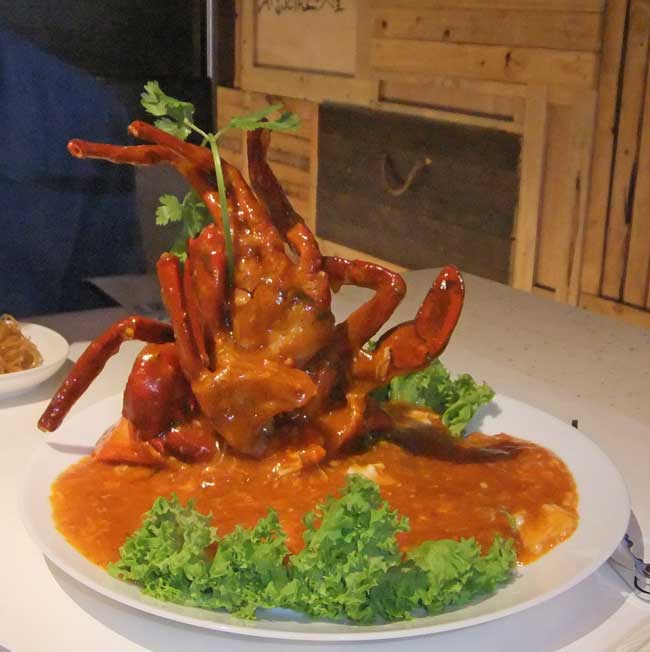
The first time I ordered chili crab in a restaurant, I didn’t know what I was getting into. The server brought out a plastic tablecloth and handed me a bib and rubber gloves, along with the usual shell-cracking implements. The crab came drenched in chili sauce, which made the cracking process a slippery job.
When I finally reached the meat, I realized why people are willing to put up with so much mess and effort to get at it: chili crab is succulent and delicious, with just the right amount of spice. If you want it hotter, dip the meat in the excess sauce pooled on the plate.
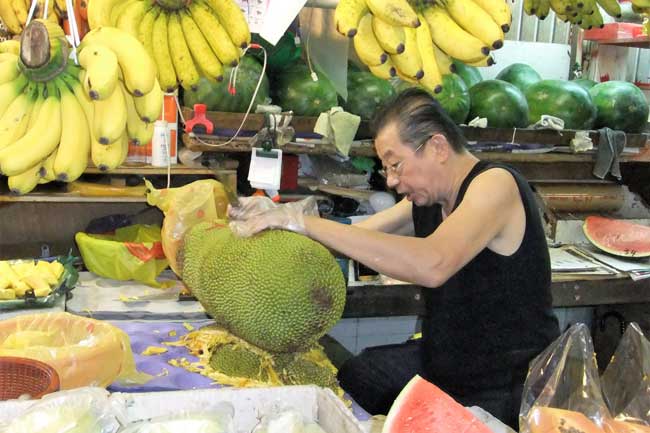
Fruit Flavors
“All the fruits and vegetables and meats are imported too,” says Bernard, as we wander the Tekka’s fruit aisles. “There’s no room in Singapore for agriculture.”
We pass a stall where a man is slicing up one of my favorite tropical delicacies—the sweet and tasty jackfruit. When I comment on the fruit’s considerable size, Bernard laughs and says, “That’s a small one!” In fact, they can grow up to 80 pounds, so be careful if you ever find yourself under the limbs of a jackfruit tree.
Beneath the knobby exterior of the jackfruit are numerous fleshy yellow seedpods—these are what you eat. The seeds are edible too and can be boiled or roasted like chestnuts.
I smell the durian before I see it. The taste of this prickly fruit is unique, and people tend to either love it or hate it. I’m somewhere in the middle; I enjoy the soft, custardy texture and buttery onion flavor going down, but find the aftertaste, which lingers way too long, unpleasant.
“It’s the smell that gets most people,” says Bernard. “Very pungent. Try not to get any durian on your hands. I always wear gloves when I eat it.”
Before leaving the market, we stop to sample a small native fruit called the rambutan. Opinions are not divided on the rambutan — it’s awesome. The exterior is red and hairy, while the inside is white, sweet and full of vitamins. If you buy some, make sure you have a knife to cut through the leathery skin.
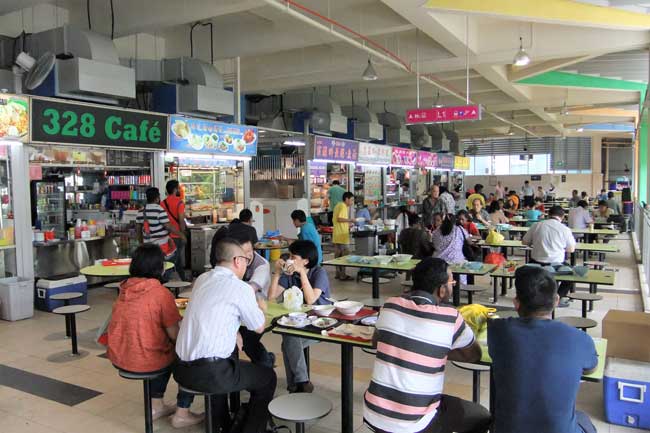
Colorful Clothes
The Tekka Centre isn’t only about eating. Upstairs, there’s a clothing market with thousands of brightly-colored Indian garments hanging on racks that reach to the ceiling. Like the food, clothes are cheap at the Tekka. Pants can be bought for as little as $5 and dresses start around $10. Prices depend on the material and embroidery involved.
Even if you’re not in the market for Indian fashion, it’s fun to walk around and admire the eye-catching designs.
Multicultural Tekka
Singapore is a melting pot, and nowhere is this more evident than at the Tekka Centre. There are Chinese food stalls next to Malay food stalls next to Indian food stalls. You’ll hear Tamil and Hokkien and Malay and Singlish (Singapore English patois) spoken.
People are a big part of the Tekka Centre’s appeal, and communal seating gives you the opportunity to make new friends. Take the time to chat, and you’ll learn a lot about life, and food, in Singapore.
If You Go
The Tekka Centre can be accessed via public transportation from anywhere in Singapore. The Little India MRT station is just around the corner, and buses stop in front of the Centre on Serangoon Road.
If you’re looking for a guide to introduce you to Singapore’s food, history and culture, contact Bernard Koh at Tour HQ: https://www.tourhq.com/guide/sg94691/bernard-koh
Tekka Centre, 665 Buffalo Rd, Singapore 210665
Hours: 6:30 am to 9 pm.
Inspire your next adventure with our articles below:
Author Bio: Dan Morey is a freelance writer based in Pennsylvania. His travel reporting has appeared in Roads and Kingdoms, BootsnAll, GoMad Nomad and elsewhere. Find him at danmorey.weebly.com.
